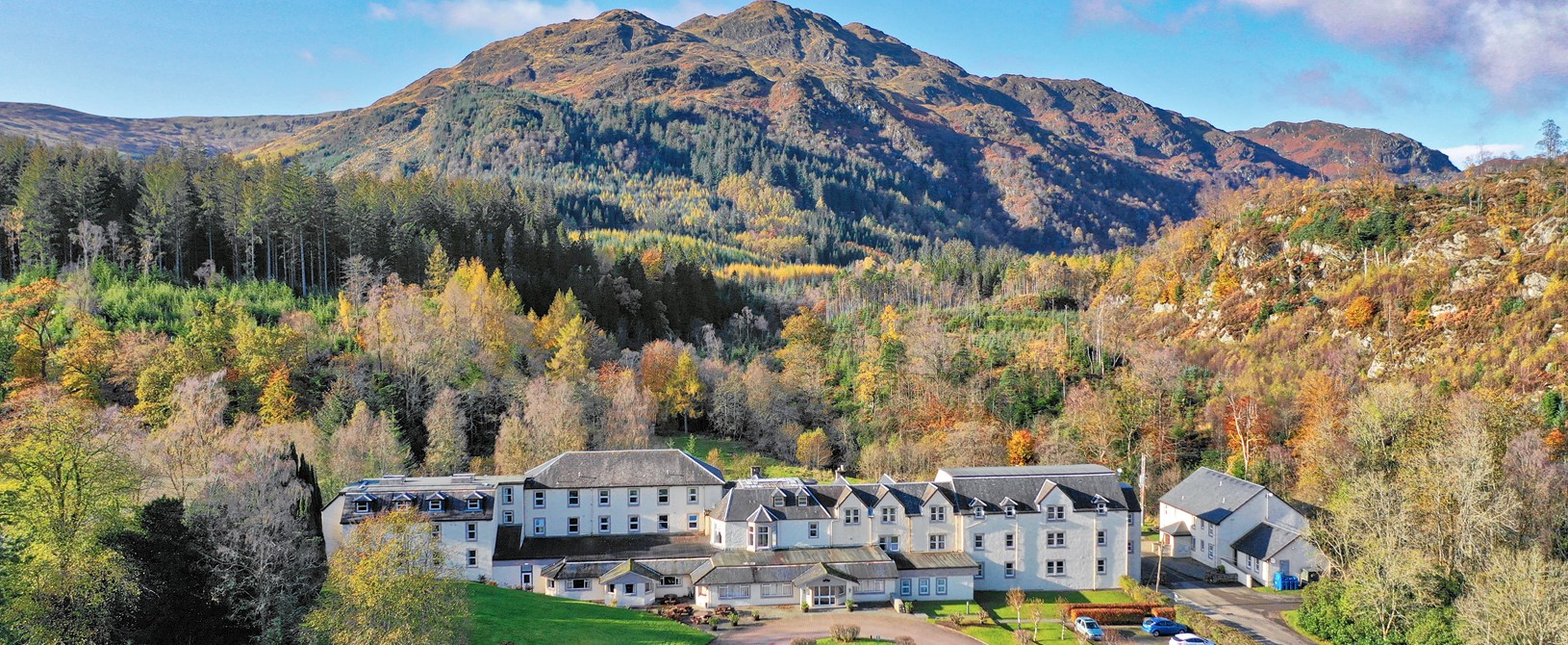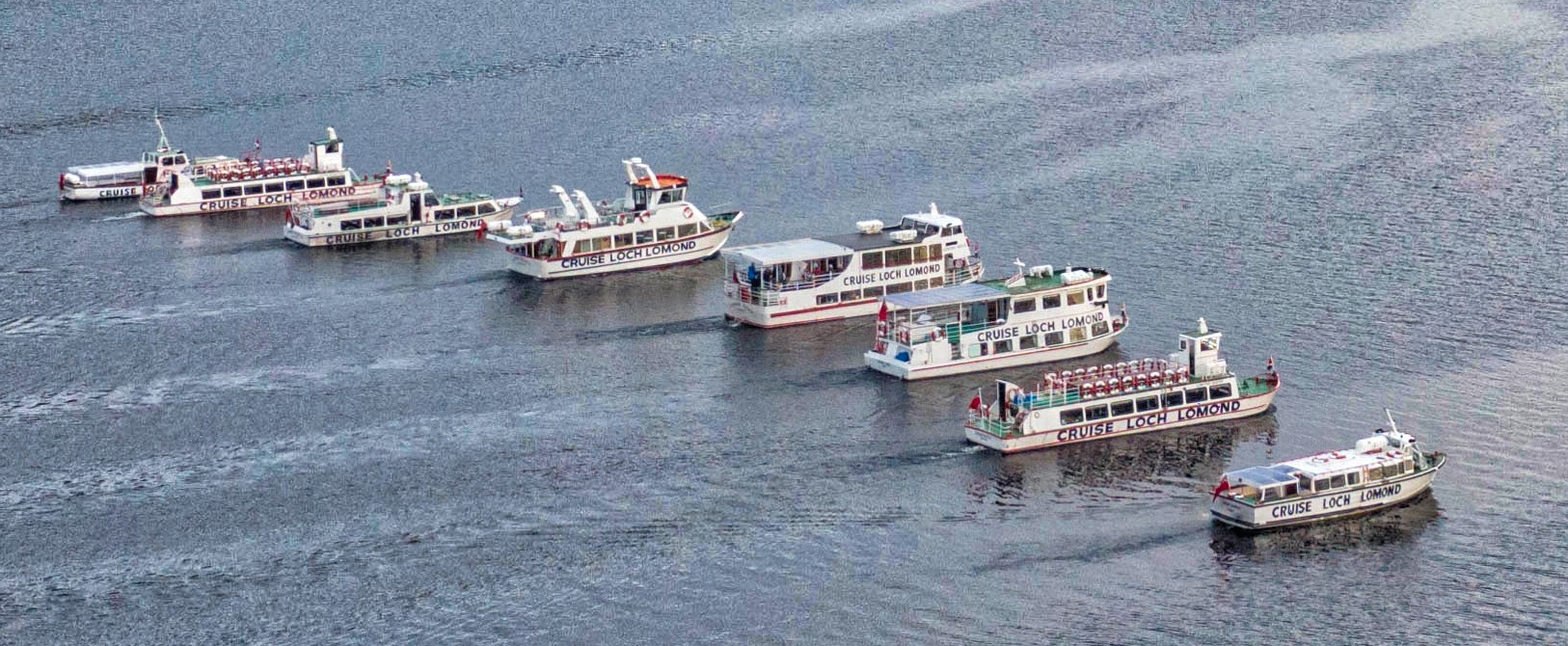Issue 52, Spring 2020

During the summer of 1987 there was a rumour that the Loch Achray Hotel was expected to go on the market. I wasn’t surprised as I had heard on the coach drivers’ grapevine that things were not going too well there. On an impulse I drove across to have a look round and, whilst in the bar, happened to meet up with the owner. We got chatting, whisky was consumed and, by the end of the evening, hands had been shaken on a deal. The next day I returned with a friend who was a chartered surveyor and, after a look round, his first words were a rather discouraging ‘Is it too late to get out of it’. But nevertheless we pressed on and took over the property.
All manner of tradesmen soon moved in as there was much to be done, not least a change of decor. All of the woodwork had been painted in an unbelievably unattractive orange brown colour. In the ballroom there was a rather startling mural of a gory battle scene that stretched the length of the room from floor to ceiling. This seemed to be a most unwise choice of subject in a hotel that catered to both English and Scottish guests as it appeared to be a scene from the Battle of Bannockburn where the English army had been routed by Robert the Bruce. However, it was all swept away together with the outdated bedroom and bathroom fittings and, after a complete refurbishment, we opened to our first guests a few months later.
It should have been a flawless opening night. There were three coaches booked to arrive in the late afternoon. The management and staff were all on parade ready to welcome their first guests, and all that remained were the piles of tools and surplus materials that were being hurriedly moved from the foyer onto the workmen’s’ trucks when...disaster, a decorator’s table was lifted to reveal a five litre tin of black gloss paint lying on its side, its contents seeping across the new pale grey and lilac carpet. The paint was scraped into buckets and every able bodied person set to with cloth, brush and white spirit. It was never to be the same again and during the next ten years every time I arrived at the hotel my eye was immediately drawn to the slowly fading stain. There was a robust investigation, but it would take 15 years before the culprit had the courage to own up.
Now, thirty years later, we are carrying out another comprehensive renovation. The hotel is to be closed from January to March to allow time for the more substantial work that cannot be done when the hotel is open, to take place. The kitchens and stores will be gutted and rebuilt to modern standards and, more obvious to our guests, the function room will be completely refurbished. As we rip out the old banquette seating, it will be interesting to see if there are any signs of the old battle scene mural left behind.
But whatever happens I am confident that no tins of paint will be stored in the foyer.
Michael Wells OBE, Chairman
Cruise Loch Lomond

I feel I am in danger of doing too much reminiscing in this edition of our newsletter, although perhaps this is inevitable at my time of life, but the story of our long association with Cruise Loch Lomond does go back to the very earliest years of our company.
In 1979 when we had just the one rather run down hotel in the village of Arrochar, finances were shaky and we depended to a great extent on revenue from the bar. Income was greatly helped by a group of local businessmen who met up each evening for a drink (or three) before going home to their wives. One of the group was Stuart Cordner and I soon discovered that he owned a cruise boat on Loch Lomond by the name of Lomond Queen and it wasn’t long before we had negotiated an arrangement for a loch cruise to be included in our holiday itineraries. This additional attraction proved to be immensely popular.
Our businesses flourished and in 1984 we acquired a second hotel and he purchased a second boat which was named the Lomond Princess. He celebrated the occasion by arranging a special cruise inviting along local hoteliers, as well as tradesman and others who had helped with the project. The event was described in the 11th May edition of the Helensburgh Advertiser in an article headed rather oddly as ‘Sailing on Champagne’. The journalist clearly loved an alliteration as he went on to say; ‘Sixty sight-seers lolled in the lap of luxury on Loch Lomond last Sunday when they sipped champagne and sampled smoke salmon...’ I was present on the occasion and don’t recall any lolling, but, typical of Stuart, it was certainly a memorable and smoothly organised event.
A few years later when the fleet had increased to three, Cruise Loch Lomond was given a contract to tow an electric cable across the loch from Inveruglas to provide additional power at Inversnaid following the hotel’s expansion. Initially the cable was fastened to just one boat, then a second and finally the third boat was called in. Although tantalisingly close to the Inversnaid Pier, there was just not enough power to haul the cable the last 100 metres. In desperation a call was put through to the hotel and with my son Neil at the helm of our little workboat Potter, that extra couple of horsepower made all the difference. I wonder if we ever got a share of the fee!
Sadly Stuart died far too young and his son (also Stuart) and nephew Fred took over the running of the Company. Under their direction Cruise Loch Lomond has gone from strength to strength and they now operate eight boats.
Fred kindly sent me the superb photo shown above featuring their entire fleet, although I must admit when I first saw it I felt a tug at the heart as there, closest to camera, I could see our ex-ferryboat Arklet now in Cruise Loch Lomond livery. For over 30 years we operated Arklet between Inversnaid and Inveruglas ferrying guests between hotel and coach. Alas, burgeoning regulations and the inevitable Health and Safety considerations made it wise for us to transfer ownership to a professional dedicated boat company.
Arklet, or Lomond Hannah as she is now called, has had an interesting history. Originally it was constructed in Glasgow in 1966 as one of four lifeboats for the MV Kungsholm, the last transatlantic liner on the Gothenburg to New York service. In 1978 it was sold to P&O and after a refit, was reborn as the Sea Princess, a glamorous cruise liner that found fame as the ship used in the TV series ‘The Love Boat’. The four launches were then used to ferry passengers between ship and shore but in the tropical waters, the engines tended to overheat and had to be replaced. One of the redundant launches found its way to a boat dealer in London where I first saw her looking very forlorn on a Thames mudbank. A deal was done and eventually we got it transported to Loch Lomond - little more than 30 miles from the shipyard that built her.
Since then she has been re-engined, fitted with a new superstructure and thoroughly upgraded. During my time at Inversnaid when Neil and I frequently skippered Arklet, I always found it hugely comforting to remember that this was a vessel designed to be used as a lifeboat able to withstand the worst mid-Atlantic weather.
We wish her and her sister ships well for the future.
Ardgartan - Before Lochs and Glens

In 1941 the annual Youth Hostel handbook stated that the Ardgartan hostel would close for wartime strategic reasons and would be requisitioned for the duration of hostilities. It reopened in 1946, becoming increasingly popular. The mid-1960’s were a golden period for the hostel, with over 11,000 overnights recorded in 1963. Accordingly, plans were drawn up to retire Ardgartan House and build an entirely new hostel. The old building was demolished and a somewhat stark Scandinavian-style replacement was officially opened on 17th May 1969.
Although the promontory of Ardgartan Hotel was first recorded in the 14th century, there is no reference of a substantial building on the site until 1665. At the end of the 18th century this structure was demolished and replaced by Ardgartan House, a rather opulent property with an interior plunge pool complete with marble steps. We were fortunate to be able to trace the above photo in Scotland’s Record Office in Edinburgh. It is thought to have been taken at the end of the 19th century.
In 1936, after 500 years of unbroken ownership by the Campbell family, Ardgartan Estate was sold to the Scottish Youth Hostel Association. The arrangement was that Ardgartan House would be converted into a hostel and the grounds would be available for camping. It was an immediate success resulting in it being chosen as the venue for an International Youth Hostel Rally and Conference to be held at the end of August, 1939.
Hundreds of young Hostellers were invited from countries throughout Europe and America. It was to be one of the biggest youth rallies ever staged in Scotland. An army of doctors, nurses, interpreters, hill guides, and camp wardens were enlisted to facilitate the smooth functioning of this great gathering of youth.
Following the fraternal greetings from delegates, the evening was planned to be spent in an open-air jamboree terminating with a huge camp fire singsong. However the timing for the event could not have been worse. Tension throughout Europe was rising rapidly and, after much debate, at the last minute it was decided to cancel the conference, and proceed with just the social side of the rally.
In the event it all passed off remarkably well. An international group of approximately 1,200 spent the night at Ardgartan, most of them in an extensive tent town, stretching along the banks of Loch Long. An impromptu concert was arranged with individuals from different countries singing and playing their folk songs and performing their national dances. It was an unforgettable, joyous occasion, but soon the delegates were packing up to return to their own countries and, just a few days later on 1st September, 1939 war was declared.
It is both sad and ironic to think that so many of those young men celebrating together would soon be fighting each other as bitter enemies.
At the dawn of the new millennium hostelling was declining in popularity. The name was changed to the Loch Long hostel in the 2000 handbook but sadly, low usage and high maintenance costs were cited as the reasons for its closure in 2001. Coincidentally, each hostel had operated for an identical span of 33 seasons.
By the time Lochs and Glens Holidays had acquired the site in 2004, the hostel was in a very sad state indeed, derelict, damp and vandalised. Negotiations for permission to build a new hotel began in earnest. We had always expected that in such a sensitive site in Scotland’s premier National Park, planning consent would not be straightforward, but none of us were prepared for just how long it would take. It would be five years before work could begin, followed by another three years of construction and then, on it’s completion in July 2012, we were finally able to proudly welcome our first guests into the brand new Ardgartan Hotel